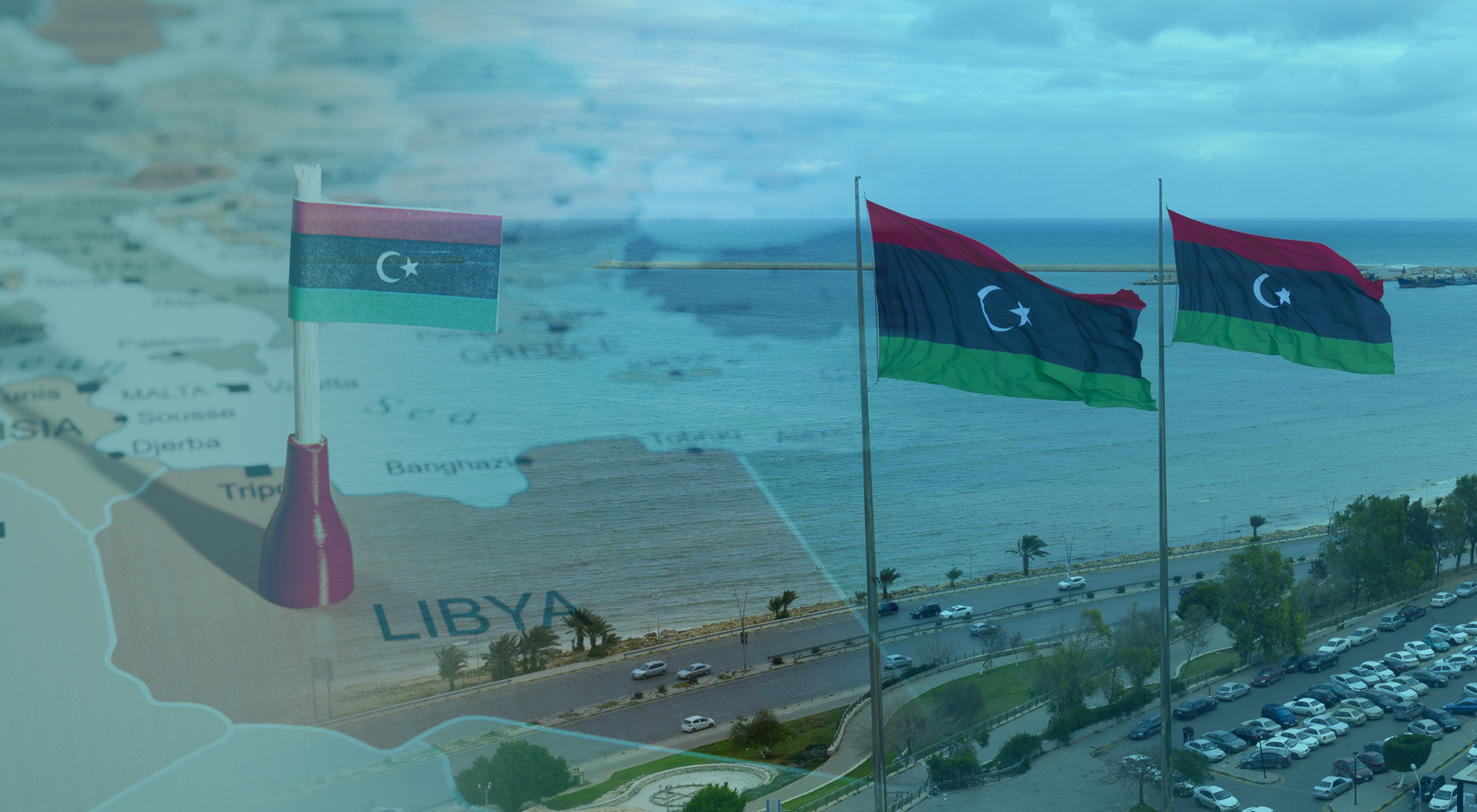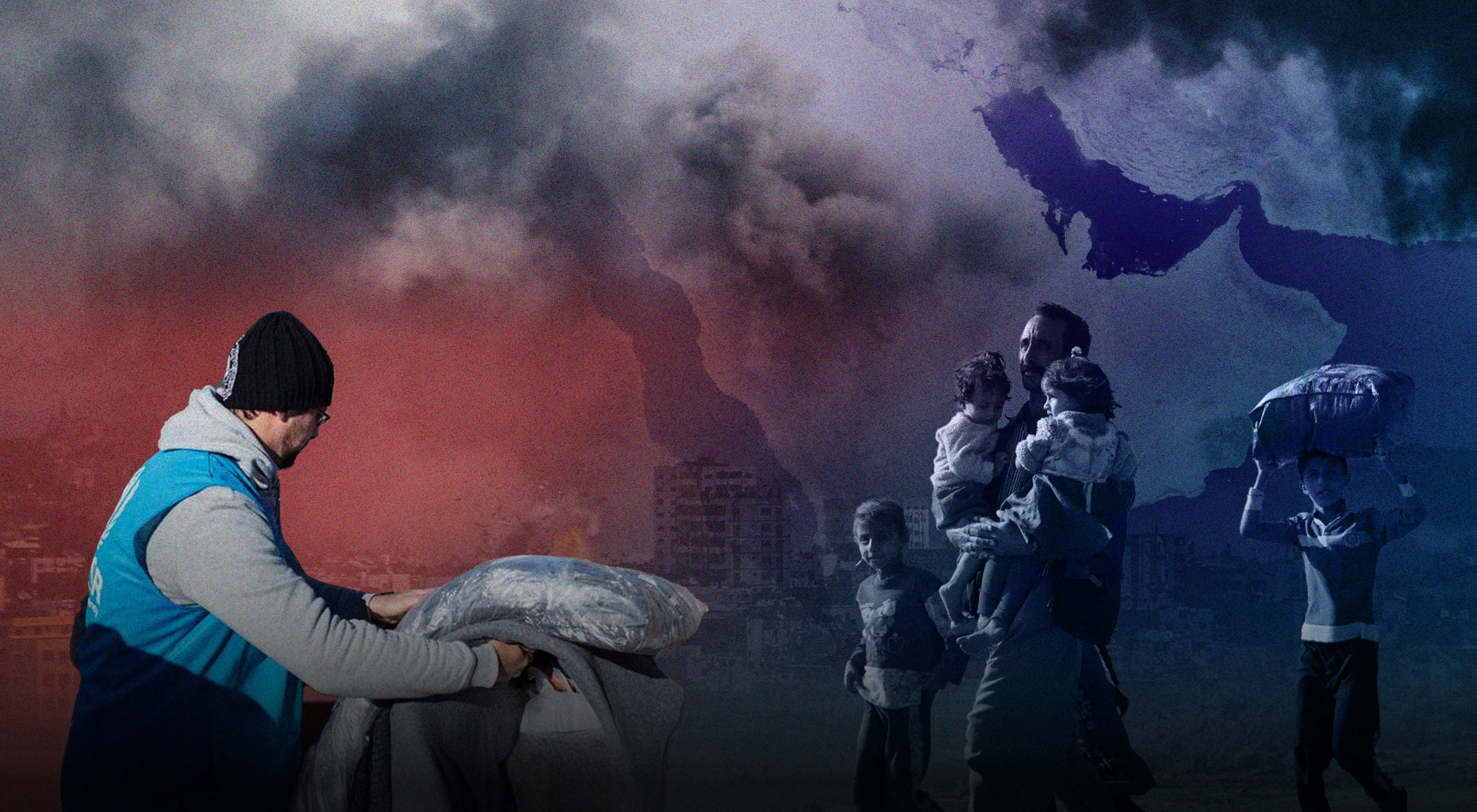In a year undoubtedly marked by the global repercussions of the conflict in Ukraine, existing trends have reinforced a realignment in the Middle East and North Africa (MENA) that could herald a new era for the region. In particular, the push towards a détente (which dates to the change of administration in the US in 2020 at least) seems anchored in the process of normalisation that involves not only Israel and its Arab partners – as we have seen so far following the Abraham Accords – but also middle powers so far engaged in a power struggle across the region, which has had devastating consequences for conflict-torn countries such as Libya, Syria and Yemen.
Faced with the difficult choice between Russia and the West, Arab leaders have increasingly adopted a neutral tone, as shown in the early days of the war by the UAE’s decision to abstain from a UN Security Council resolution to condemn Moscow. This new non-alignment[1] has been eased by several factors, including the unpredictable and erratic policies of Western partners, which have frequently led to serious misunderstandings on the most pressing issues, such as Afghanistan: in the eyes of Arab leaders, the chaotic withdrawal has certainly magnified Washington’s disengagement from the region, leading to the conviction that their security interests do not always coincide with those of the West.
Between normalisation and diversification
The neutral stance adopted by many governments in the region calls into question the commitment of traditional security providers while confronting emerging threats, already tested during the Trump administration. On the other side, it also shows how Arab leaders are now forced to increasingly hedge their bets for the same reason. A regional heavyweight, Saudi Arabia, is certainly a case in point and the timing of the recent visit of Chinese President Xi Jinping is particularly telling. Despite the considerable efforts made by Washington to mend ties with Riyadh, the deterioration of Saudi-US relations clearly shows all the limits of the recalibration policy promised by President Joe Biden during his election campaign.
At the same time, the changing regional landscape is forcing local stakeholders to finally get together and elaborate on endogenous solutions to the multiple crises affecting the region.[2] An inside-out strategy involving the warming of ties between former geopolitical rivals suggests that a modus vivendi is taking shape in the Middle East, paving the way for a new era of peace after the chaotic decade of the Arab Spring. Among the flurry of normalisation deals, which also saw Israel and Turkey restoring ties and Syria warming relations with its neighbours, negotiations between Iran and Saudi Arabia remain crucial, provided that a comprehensive settlement is found at a critical time for Tehran.
For the first time in years, the region can finally move towards de-escalation, but there are dangers just around the corner, which could reinforce, instead of heal, the regional divide. Calls for the establishment of an Arab NATO[3] are in line with Washington’s desire to fill the void resulting from its disengagement, but it risks giving a military dimension to the normalisation front that could further antagonise rival blocs. A return to polarisation in the Middle East would close this promising window of opportunity, exposing the normalisation trend for what it really is: a strategy of diversification to minimise the risks of a direct confrontation, most visible during the brinkmanship years of 2019-2020.
A resuming political polarisation
The intractable conflicts festering across the region will soon become the main stress test for the strategic pause adopted by regional powers so far. Many of these conflicts are now hanging in a precarious balance characterised by fragile ceasefires and lack of comprehensive political settlements, stuck in a no-man’s-land and prone to escalation at any time. Libya, where sporadic clashes are shaking the ceasefire agreement signed by rival parties in October 2020, is certainly a case in point. Fighting resumed this summer, when Tripoli witnessed its worst outburst of violence in two years, as rival armed groups battled in the streets of the capital, leaving 42 people dead and nearly 160 injured.[4]
The fighting erupted after the Stability Support Apparatus (SSA), affiliated with the Government of National Unity (GNU), came under attack from rival militias led by Haitham al-Tajouri, former head of the Tripoli Revolutionary Brigades (TRB), now siding with the rival Government of National Stability (GNS). The clashes, which saw the SSA prevail, also dealt a huge blow to the GNS-affiliated Nawasi Brigade, which lost their headquarters in the capital. Zintan forces loyal to Maj.-Gen. Osama al-Juwaili, commander of the western military zone of the Presidency Council (PC) but now close to the GNS Prime Minister Fathi Bashagha, also took part in the clashes as well as militias from Misrata, Warshafana and Zawiya.[5]
The polarisation associated with the return to rival governments vying for power, a common feature of post-2014 Libya, has been the major driver of this dangerous escalation,[6] which alongside displaying the fragile and precarious basis of the status quo, is also casting a long shadow over an already faltering peace process. New fault lines have emerged, as powerful militias quickly adapt to a changing political landscape, characterised by the return to a duopoly of power after the failure to hold elections late last year. The hybridisation of the security sector has led to an oligopoly of the use of force that represents the main obstacle to the peace process.
Rival authorities act as political fronts, a façade with no real power on the ground, only able to give free access to state institutions and resources to the different conglomerate of militias, legitimising the predatory behaviour of armed groups always ready to switch sides – a volatile situation that frequently leads to major frictions, as shown this year by the establishment of the GNS that tested the resilience of the rival GNU. The resulting political deadlock also highlighted the comeback of General Khalifa Haftar, a pariah after his failed attack on Tripoli but now perfectly at ease in his new role as kingmaker, able to disguise his well-known political aspirations behind the rise of Bashagha.
The weaponization of oil
As stressed by his recent meetings with high-ranking international officials, the Field Marshal of the Libyan National Army (LNA) is now considered a key stakeholder, capable of standing his ground. The oil blockade imposed since April by local groups in areas under his control provide further evidence of Haftar’s regained strength. It only ended after the GNU appointed Ferhat Bengdara as the new chairman of the National Oil Corporation (NOC). Former governor of the Central Bank of Libya (CBL), Bengdara is considered particularly close to Haftar, who did not shy away from using Libya’s main resource as a political weapon once again, this time to force the hand of rival Prime Minister Abdel-Hamid Dbeibah.[7]
To the consternation of many Western powers (including Italy and the US) that enjoyed excellent relations with his predecessor Mustafa Sanalla, Bengdara took office in a quid pro quo that, alongside receiving the imprimatur of regional powers with a stake in the Libyan conflict, also showed the full extent of the power-sharing practices adopted by Libyan political dinosaurs. As shown by the recent collapse of the dialogue process between the House of Representatives (HoR) and the High Council of State (HCoS), the main goal of an ageing and discredited political elite is simply to preserve the untenable status quo and indefinitely delay the elections.
Roadmaps to nowhere
In a survival mode, Libyan politicians presented roadmaps for elections, but based on their own terms. They are clearly kicking the can down the road, only to increase the frustration and the resentment of the Libyan population, who is eager to turn the page after a decade of conflict and increasing economic hardships. In a context marked by the visible socio-economic implications of the conflict in Ukraine, it is fair to say that the resumption of oil production (now hovering around 1.2 million barrels per day) came at a critical time. Indeed, in early July, the deterioration of living conditions pushed many Libyans to take the streets, in a show of force against public authorities, which reached unprecedented heights.[8]
The widespread protests emphasised the legitimacy crisis of the main political institutions not only in Cyrenaica, but also in Fezzan and Tripolitania, where demonstrators called for the dissolution of the parliament and new elections.[9] Growing popular unrest is finally raising pressure on discredited elites embedded in rival authorities running the country from both Tobruk or Tripoli, confirming the need of a reset and political turnover. Calls for the Presidency Council (PC) to take the initiative and dissolve all existing political bodies are spreading, while the idea of restoring the monarchy is increasingly gaining traction.[10] Both options, however, only represent quick fixes to a protracted conflict that does not necessarily need to be addressed from a populist or authoritarian perspective.
Friends and foes
In this ongoing political deadlock, a new power struggle is taking shape. The resulting volatility could derail the peace process but, for the time being, the ongoing rapprochement between regional foes serves as a counterbalance to the uneasy domestic situation.
At the same time, warming relations between Egypt and Qatar, emphasized by President Abdel Fattah al-Sisi’s visit to Doha in September,[12] could also have a positive impact, moving away from the zero-sum game that has characterised the region in the past few years towards a competitive collaboration among equals that seems more in line with the emerging regional trends. It is fair to say that the decline of political Islam, receding both on the ground and at the polls, has cleared the way for these reconciliation attempts.
However, it is not yet clear if these new friendships will become a structural feature of the new regional order or remain merely provisional. An opportunistic approach could have cascade effects on the Libyan conflict: for example, Cairo’s staunch support for Bashagha, highlighted by the walkout of the Egyptian delegation at the September meeting of the Arab League in which the GNU’s Foreign Minister Najila al-Mangoush assumed the chairmanship,[13] speaks volumes about Egypt’s preferences. After years in which Cairo had re-established ties with authorities in Tripoli and signed lucrative contracts with the GNU, the about-face shows how the over-arching principles of Egypt’s policy in Libya have remained the same, despite the strategic pause.
The East Med conundrum
Similarly, the Turkish involvement in the latest clashes of Tripoli is a reminder of the influential role that Ankara still plays on the ground. More importantly, the memorandum of understandings (MoUs) on energy cooperation between Turkey and the GNU opened a new chapter in the struggle for Libya, revealing where Ankara’s strategic interests really lie in Libya.[14] The agreements, which paved the way for joint Libya-Turkish oil and gas exploration in contested waters of the Mediterranean Sea, were signed just after Dbeibah had managed to consolidate its position in the capital after being challenged by his rivals, offering Ankara an easy option to the GNS-GNU dilemma to be shored up with further military support.
Rejected by the domestic opposition, the preliminary deals have also drawn international scrutiny, significantly escalating tensions between rivals, Greece and Turkey, due to the linkage between the Libyan conflict and the dispute in the Eastern Mediterranean. The correlation, which stemmed from the previous MoU on the delimitation of the maritime boundaries and economic exclusive zones (EEZs) signed between Turkey and the GNU’s predecessor in Tripoli in 2019, has increasingly pushed Egypt and Greece to align against what they perceive as Turkish encroachments in contested areas rich in hydrocarbon resources:[15] the establishment of the Eastern Mediterranean Gas Forum (EMGF) clearly served this purpose, revealing the existence of an anti-Turkey axis in the East Med.
The reverberations of these resuming tensions have not been limited to the East Med but have had a direct impact on the Libyan conflict itself, given the growing entanglement between the two. In November, the controversial visit of the Greek Foreign Minister Nikos Dendias to Libya resulted in a serious diplomatic incident: by refusing to disembark in Tripoli not to meet with GNU officials and by landing in Benghazi to meet with Haftar and the speaker of the HoR Agila Saleh, Dendias showed all the risks of picking sides in a fragmented country[16] – a selective approach that could certainly be detrimental to the peace process and further deepen the regional divide between eastern and western Libya.
The litmus tests
In times of global energy crisis, the East Med conundrum really represents the ultimate litmus test for the normalisation trend in the region, particularly for Egypt and Turkey. Despite more frequent talks between President Abdel-Fattah al-Sisi and his counterpart Recep Tayyip Erdogan (more recently in Doha on the sidelines of the FIFA World Cup), Ankara and Cairo seem still engaged in a zero-sum game that could have important reverberations on the East Med and the Libyan files, now interconnected after the MoUs signed by Turkey with its main Libyan interlocutors. The addition of Greece to this complex equation complicates matters further, especially in consideration of the elections that await both Ankara and Athens next year.
Considering the high stakes, both Greece and Turkey have not refrained from upping the ante several times.[17] A show of force in the East Med cannot be ruled out and this scenario could provide another litmus test, this time for Libya – at the moment, not high on the agenda due to the ongoing conflict in Ukraine. Hampered by divisions, the international community continues to focus on the form (for example, the recently established P3+2+2) and not the content.[18] At the same time, the new UN Special Envoy Abdoulaye Bathily seems deprived of the room to manoeuvre to present a new plan that could change the paradigm around the peace process, moving away from the paralysing elections-constitution dilemma.
In a country where militias roam free, preventing parliamentary sessions to take place and even organising workshops on the importance of fighting corruption, reinforcing existing mechanisms such as the Joint Military Commission (JMC) could represent a viable option especially in terms of Security Sector Reforms (SSRs) and Disarmament, Demobilisation and Reintegration (DDR) programs, which are aspects often overlooked. However, without addressing the main structural issues that continue to undermine the transition (including the reunification of the military and the redistribution of oil revenues), the risk is that despite the visible changes on the surface, everything will remain the same underneath. In that case, a united Libya could be forever lost in transition.
References
[1] Particularly visible in the Maghreb as pointed out by the policies adopted by Algeria and Tunisia immediately after the start of the conflict in Ukraine. See Benoît Delmas, “Le fantôme de Bandung,” Le Point, May 15, 2022, http://bitly.ws/xSbI.
[2] “Since 2021, all parties have worked towards de-escalation—partly out of their realization that US disengagement from the region implied that they had to take matters into their own hands,” as quoted by Jean-Loup Samaan in “The New Middle East Is Dismissing Great Power Competition – For Now,” Atlantic Council, October 18, 2022, http://bitly.ws/xSbX.
[3] Especially from the Israeli side. See “The Myth of an Emerging ‘Mideast NATO’,” International Crisis Group, October 3, 2022, http://bitly.ws/xScd.
[4] United Nations, “Libya: Political Stalemate and Lack of Progress on Elections,” UN News, August 30, 2022, http://bitly.ws/xShJ.
[5] Sami Zaptia, “Major Tripoli Militia Clashes Result in 32 deaths and 159 Injuries,” Libya Herald, August 28, 2022, http://bitly.ws/yCbm; Abdulkader Assad, “Clashes in Tripoli on Halt as Bashagha’s Misrata Forces Withdraw,” Libya Observer, August 27, 2022, https://cutt.ly/n2vyTOH.
[6] “The establishment of a rival executive authority revived the political polarisation between eastern and western Libya” – International Institute for Strategic Studies (IISS), Armed Conflict Survey 2022 (Routledge, 2022): p. 179.
[7] By calling for a halt of the oil exports from Libya last April, the LNA was “exerting political pressure on the Prime Minister of the GNU, Abdelhamid Dbeibah, to force him to leave office and allow Bashagha to enter Tripoli,” as quoted by Umberto Profazio in “The Bonds That Tie Libya and Ukraine,” Trends Research and Advisory, May 17, 2022, http://bitly.ws/xScG.
[8] “Libyan Protest Movement Says It Will Step Up Its Campaign,” Reuters, July 3, 2022, http://bitly.ws/xSpv.
[9] “Libyans are clearly demanding that the entire political class be replaced with a government that actually governs,” as quoted by Tarek Megerisi in “Never Let a Good Crisis Go to Waste: How Europe Can Respond to Libya’s Riots,” European Council of Foreign Relations (ECFR), July 6, 2022, http://bitly.ws/xSd6.
[10] Abdulkader Assad, “Libya’s Presidential Council Says It’s Always Convening to Materialize Libyans’ Desire for Change,” Libya Observer, July 2, 2022, https://cutt.ly/p2vuvUl; Sami Ibrahim Elalem, “Constitutional Monarchy Can Save Libya from Anarchy,” The National Interest, August 23, 2022, http://bitly.ws/yCco.
[11] The UAE in particular has been “increasingly exporting a vision of foreign policy that [centers] around pragmatism, economic stability, and trade partnership in light of the [Abraham] accords,” as quoted by Emadeddin Badi in “The UAE Is Making a Precarious Shift in Its Libya Policy. Here’s Why,” Atlantic Council, October 27, 2022, http://bitly.ws/xSdB.
[12] The Arab Republic of Egypt Presidency, “President El-Sisi and Amir of Qatar, HH Sheikh Tamim, Hold Talks in Doha,” September 14, 2022, http://bitly.ws/xSxw.
[13] Hamza Hendawi, “Egypt Walks Out of Arab League Meeting in Protest against Libyan Leadership,” The National, September 6, 2022, http://bitly.ws/yCd8.
[14] Ahmed Elumami, Ayman al-Warfali, and Ali Kucukgocmen, “Turkey-Libya Preliminary Deal Prompts Greece, Egypt to Push Back,” Reuters, October 3, 2022, http://bitly.ws/yCdj.
[15] Sean Mathews, “Eastern Mediterranean Tensions Escalate after Preliminary Turkey-Libya Maritime Deal,” Middle East Eye, October 4, 2022, https://cutt.ly/s2viUhT.
[16] Umberto Profazio, “Echoes from the Libyan Past,” Maghreb Strategic Trends, NATO Defence College Foundation, November 29, 2022, http://bitly.ws/xSdI.
[17] Following recent threats from Erdogan, tensions escalated further when Exxon Mobil started conducting seismic surveys southwest of the Peloponnese peninsula and the island of Crete, following a navigational warning by the Greek navy. See “Exxon Mobil Started Seismic Surveys off the Peloponnese, Crete,” Ekathimerini, November 10, 2022, http://bitly.ws/xSe6.
[18] “International Powers Confirm Support for Libyan Elections during Wilton Park Talks,” The Libya Update, October 29, 2022, http://bitly.ws/yCem.
Ok, I have made a few changes here.








